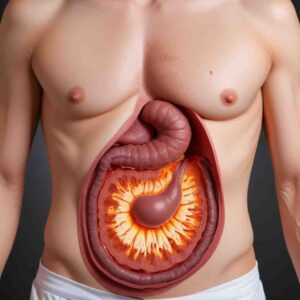Gallbladder removal surgery, also known as cholecystectomy, is a common way to deal with gallstones. It stops the painful attacks caused by gallstones, but sometimes it leads to new stomach problems like gastritis. This article looks at how gastritis and gallbladder surgery are connected, what signs to watch for, and ways to feel better, focusing on “Gastritis After Gallbladder Removal.”
What the Gallbladder and Bile Do
The gallbladder is a tiny, pear-shaped organ that sits under your liver. It holds bile, a liquid made by your liver to help digest food. Bile is important for breaking down fats in your gut to help with digestion. When you eat fatty foods, the gallbladder squeezes out bile into your gut to help break down those fats.
Why Does Gastritis Occur After Gallbladder Removal?
After your gallbladder is removed, bile from your liver goes straight into your small intestine all the time instead of being stored up. This change can bother your stomach lining and cause inflammation, which is called gastritis. Here’s why this happens:
- Bile Flows Without Control: Since there’s no gallbladder to control it, bile might flow into your stomach unexpectedly, which can be irritating.
- Less Concentrated Bile: When bile is stored in the gallbladder, it becomes stronger, helping to break down fats better. Without the gallbladder, bile isn’t as concentrated, so it might not work as well at digesting fats, leading to stomach discomfort.
- Digestion Gets Messed Up: The way your stomach’s digestive juices work can get messed up because of the changes in bile flow. This can cause inflammation and make your stomach feel uncomfortable.
| Category | Details | Sub-Details | Additional Information |
| 1. Digestive Changes | Altered bile flow and digestive function | – Bile Flow: Without the gallbladder, bile continuously drips into the intestines, which may irritate the stomach lining. | Continuous bile flow can lead to increased acid and bile reflux into the stomach. |
| – Digestive Changes: Changes in digestion and absorption can affect stomach health and cause inflammation. | This can lead to symptoms similar to gastritis, such as abdominal pain and nausea. | ||
| 2. Gastric Acid Overproduction | Increased stomach acid production | – Acid Reflux: Bile reflux can lead to increased gastric acid and irritation of the stomach lining. | Acid reflux can exacerbate gastritis and lead to chronic discomfort. |
| – Dietary Changes: Post-surgery dietary changes may inadvertently increase acid production or irritation. | Spicy, fatty, or acidic foods can aggravate the condition. | ||
| 3. Infection or Inflammation | Development of infection or inflammation | – Helicobacter pylori: Infection with H. pylori bacteria can cause gastritis and may be exacerbated post-surgery. | Testing for H. pylori may be necessary if gastritis symptoms persist. |
| – Post-Surgical Inflammation: Surgery can induce temporary inflammation in the stomach lining. | This inflammation can contribute to gastritis-like symptoms following surgery. | ||
| 4. Stress and Lifestyle Factors | Impact of stress and lifestyle on stomach health | – Stress: Psychological stress can increase stomach acid production and contribute to gastritis symptoms. | Managing stress through relaxation techniques and lifestyle adjustments can help alleviate symptoms. |
| – Lifestyle Factors: Smoking, alcohol, and certain medications (e.g., NSAIDs) can exacerbate gastritis. | Avoiding irritants and making healthier lifestyle choices can reduce gastritis symptoms. | ||
| 5. Diagnostic and Treatment | Methods for diagnosing and treating gastritis post-surgery | – Diagnostic Tests: Endoscopy, gastric biopsy, and blood tests to identify inflammation or infection. | Endoscopic examination can help visualize the extent of gastritis and rule out other conditions. |
| – Treatment Options: Medications (e.g., antacids, PPIs, H2 blockers), dietary adjustments, and managing stress. | Treatment focuses on reducing stomach acid, managing symptoms, and addressing underlying causes. |

Symptoms of Gastritis After Gallbladder Removal
After getting your gallbladder removed, some people might have gastritis, which can cause:
- Upper Belly Pain or Burning: You might feel a burning or gnawing pain in the middle of your upper belly, just below your ribs.
- Feeling Sick and Throwing Up: You could feel oily, especially after eating fatty foods. Sometimes, you might even throw up.
- Trouble Digesting and Feeling Swollen: You might feel really full and swollen in your upper belly after eating. You might also burp a lot.
- Not Feeling Hungry: Because of the discomfort from gastritis, you might not feel like eating much, leading to weight loss.
| Related: Upper Right Abdominal Pain After Gallbladder Removal |
Management and Treatment Options
Thankfully, dealing with gastritis after gallbladder surgery isn’t too hard. Here’s how to feel better:
- Change Your Diet: Stay away from fatty, oily, and spicy foods. Eating smaller meals more often can help your stomach.
- Take Medicine: Antacids can calm down your stomach acid and make you feel better for a while. Your doctor might also give you pills called proton pump inhibitors (PPIs) to reduce stomach acid and help your stomach heal.
- Change Your Lifestyle: Try to relax more, get good sleep, and avoid smoking and drinking too much alcohol. These things can all help your stomach feel better and reduce gastritis symptoms.
Diagnosis and Evaluation
If someone shows signs of gastritis after gallbladder removal, they need a thorough medical checkup. Here’s how it usually goes:
- Medical History and Physical Exam: The doctor looks at the person’s medical history and does a physical exam to spot signs of gastritis.
- Endoscopy: They might use a thin tube with a camera to look inside the stomach and check for inflammation or other issues.
- Biopsy: During the endoscopy, they might take a small sample of tissue to study it more.
- Blood Tests: These can show if there’s anemia or an infection.
- Stool Tests: These can find H. blood in the stool or Helicobacter pylori.
- Imaging: They might do ultrasounds or CT scans to rule out other reasons for belly pain.

Living With Gastritis After Gallbladder Removal
Even though gastritis can happen after gallbladder surgery, it doesn’t have to make life hard. By working with your doctor, making changes to what you eat and how you live, you can control the symptoms and feel better. Here are some more tips for managing gastritis after gallbladder removal :
- Watch Your Food: Pay attention to how different foods affect you. Writing down what you eat can help you figure out what to avoid.
- Drink Water: Drinking lots of water during the day can help calm down stomach acid and make digestion easier.
- Try Probiotics: Probiotics are tiny living things that can help your gut work better. They might help with digestion and make inflammation go down.
- Relax: Stress can make stomach problems worse. Doing things like yoga or meditation can help you relax and feel better.
Conclusion
Dealing with gastritis after gallbladder removal can be tough, but with the right knowledge, prompt diagnosis, and good treatment, patients can feel a lot better and enjoy life more. It’s important to find out what’s causing the problem, make changes to your lifestyle if needed, and follow your treatment plan. By teaming up with your healthcare providers, you can handle the post-surgery period better and feel more sure about getting better.

